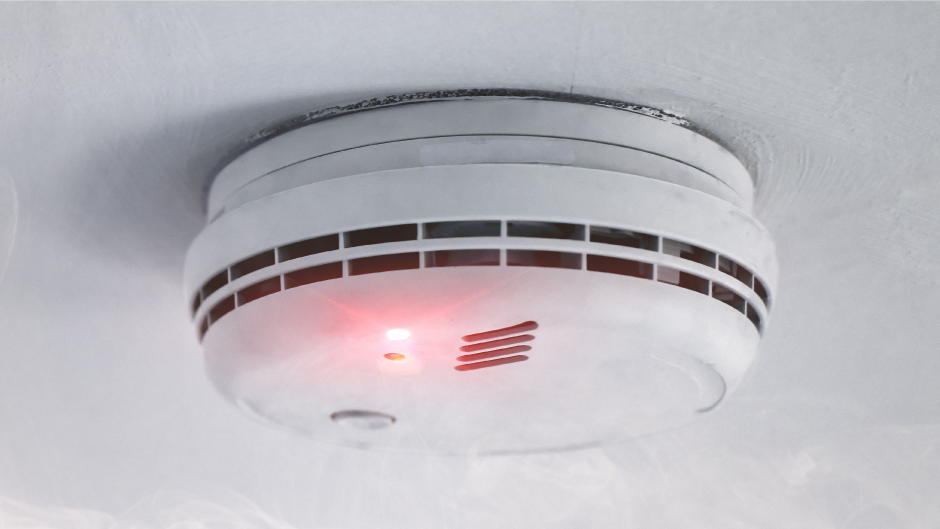- Your safety
- Home safety
- Smoke Alarms


Smoke alarms save lives
A smoke alarm (also known as a smoke detector) is a device that detects fire in its early stages and gives a loud audible warning.
There are currently two types of smoke alarms on the market - ionisation and optical (also described as photoelectric or photoelectronic.)

Ionisation alarm
Costing from under £5 these are by far the cheapest smoke alarms you can buy, but this does not mean they are in any way less effective. They are marginally less sensitive to slow burning and smouldering fires that give off larger quantities of smoke before flaming, but will detect flaming fires such as chip pans quickly before the smoke gets too thick.

Optical alarm
These are more expensive but more effective at detecting larger particles of smoke that are given off by slow burning fires, such as smouldering foam filled upholstery and overheated PVC wiring.
Each type looks similar and is powered by battery, mains electricity or both. When deciding on which type of smoke alarms to buy, you should consider which type of fire is more likely to occur in your home. However, the best protection would be to fit both and make sure that they have a continuous power supply such as mains power with a back-up battery. Any smoke alarm that you buy should meet British Standard BS EN14604: 2005 and carry the well-known Kitemark. Heat detectors are recommended for your kitchen - to detect fires in kitchens.
Conventional smoke alarms work by emitting a loud noise when smoke is detected, providing the vital early warning of fire, and therefore aiding escape. People who are deaf or hard of hearing need additional ways of making them aware the alarm has been activated, including vibrating pads and flashing strobe lights.
Deaf people need to place a vibrating pad under their mattress or pillow at night. If smoke is detected, the alarm will sound and set off the pad to assist in waking them.
British Standard BS5446-3:2015 specifies smoke alarm kits for deaf and hard of hearing people. Products made to this standard give deaf people assurance of quality smoke alarms designed to meet their needs.
The emergency SMS service lets deaf and hard of hearing people in the UK send an SMS text message to the UK 999 service where it will be passed to the police, ambulance, fire rescue or coastguard as appropriate.
Simply by sending an SMS message to 999 you can call for help and the emergency services will be able to respond to you.
You will need to register your mobile phone before using the emergencySMS service:
For maximum protection a smoke alarms should be fitted in every room of your house except the bathroom, kitchen and garage. A heat detector should be fitted in the kitchen.
For minimum protection at, least one alarm should be fitted on each level of your house.
Smoke alarms are simply screwed into the ceiling and should normally be fitted at least 30 centimetres (12 inches) away from any wall or light fitting and as close to the centre of the room, hallway or landing as possible. Always read the manufacturers instructions before fitting.
Your smoke alarms needs regular maintenance:
Once a year replace the battery - this is also applicable for mains powered smoke alarms that have a battery back-up.
Once a week check the alarm by pressing the test button.
Once a year vacuum and wipe the smoke alarm casing to ensure dust isn't blocking the sensor chamber.
If your smoke alarm is making an intermittent bleeping/chirping noise, please follow these steps:
Check that your smoke alarm is definitely the source of the bleeping/chirping; make sure the noise isn't coming from another alarm (smoke/carbon monoxide/gas/burglar alarm) by process of elimination.
Clean the alarm as per the instructions above.
Test the alarm by pressing the 'test' button.
Change the battery (unless it's a ten-year alarm).
Was your home built between 1992 and 2008? If so, its hard-wired smoke alarm detector heads need replacing as research shows that they have a 10-year shelf life and may no longer work when you need them to.
This advice could save your home and your and your family’s lives.
For more information - Is your smoke alarm more than 10 years old?
New safety laws for landlords came into force on 1 October 2015. The new safety laws make it compulsory for all landlords to fit smoke alarms in rented homes, as well as offering protection against carbon monoxide poisoning.
The new safety laws make it compulsory for all landlords to:
Fit at least one smoke alarm on each floor of their premises
Fit a carbon monoxide alarm in rooms containing a solid fuel appliance
Check that all alarms are working when a new tenancy starts - with potential penalties of up to £5,000 if they don’t comply.
Landlords must check the alarms are working at the start of every new tenancy with potential penalties of up to £5,000 if they don't comply.
Tenants are required to check the alarms are in working order and notify the landlord if they identify any problems.
Leaflet - smoke alarms (new window, PDF 252KB)
By taking some simple precautions you can prevent a fire from happening – making everyone in your home a lot safer. During a home fire safety check, we will provide fire safety advice suited to your individual needs and home.
Last updated: Wednesday, 7 February 2024